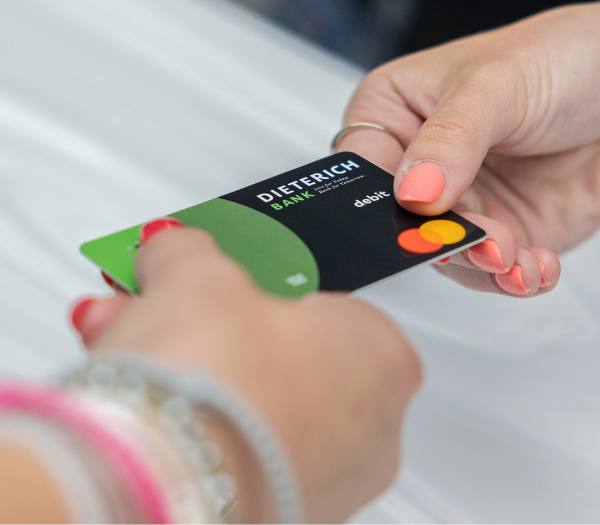Credit & Debit Cards
If you have been considering adding variety to your wallet, we have solutions for you!

Credit Cards
Enjoy our lineup of credit cards designed to fit your unique lifestyle and financial needs!
To Apply or learn more about your options, visit the link below.
Platinum Card
Enjoy the everyday convenience of a credit card while saving on interest with an extended low introductory rate.
Everyday Rewards+ Card
Earn up to 4x unlimited points.
Max Cash Preferred Card
Get more value with cash back.
Travel Rewards+ Card
Earn points on travel and more!
Reserve Rewards+ Card
Enjoy premium rewards and benefits.
College Real Rewards Card
Earn points on your purchases and work towards building a strong financial future.
Max Cash Secured Card
Make improving your credit score even more rewarding with cash back options!
Secured Card
A perfect option for anyone who wants to improve or establish credit.
Debit Cards
All your favorite card perks in one place with a Dieterich Bank Debit Card:

Instant Issue
on-the-spot activation & personalized service

Mobile Wallet
fast & secure payments!

Turn off/on whenever you need
control when you need it most

Easy to use app access
24/7 access to all your accounts!
Ready to Manage your Money online?
Experience the ease and convenience of Dieterich Bank’s online and mobile banking.
What security benefits does Dieterich Bank offer for debit cards?
All of Dieterich Bank’s debit cards are equipped with EMV Chip Technology, which means they offer advanced security when making in-store purchases at chip terminals or ATMs. Even better, our Instant Issue Debit Card Program allows you to receive your EMV debit card for your consumer, business, and HSA cards at any Dieterich Bank location the same day that you open your account.
Instant Issue Debit Cards
Why wait a week for your debit card when we can get you one NOW!? We offer Instant Issue cards, so you will receive your consumer, business, and HSA cards the same day that you open your account. This feature doesn’t only benefit you at account opening…It also comes in handy if your current Dieterich Bank debit card is ever lost or stolen. We can cancel your old one and issue you a new one…Instantly! Simply stop by any Dieterich Bank location to have a new card printed. Once you have your card in hand, be sure to add your Dieterich Bank debit card to your mobile wallet.
Mobile Wallet
Now, you can make purchases without your physical plastic card! Carry your Dieterich Bank cards in digital form by adding them to the mobile wallet on your smartphone, tablet, or smartwatch. Add your Dieterich Bank card to these mobile wallets: Apple Pay®, Google Pay™, or Samsung Pay®. Find out more.
EMV Chip Cards
EMV Chip cards are payment cards that have an embedded chip which is commonly used in place of the magnetic stripe. EMV, which stands for Europay, MasterCard and Visa, is becoming the global standard for credit card and debit card payments. There are more than 3.4 billion chip cards issued across the globe. The U.S. is actually the last major market still using the magnetic-stripe card system. Many European countries moved to EMV technology to combat high fraud rates years ago.
How do I make a payment on my Dieterich Credit Card?
Access our credit card self service to manage your account online and submit online payments.
Log into Self ServiceHow do I report a lost or stolen Debit Card?
Report a lost or stolen Debit Card immediately:
- Call (800) 699-9766 *Follow the prompts for after hours
- Call or visit a branch
- Send a secure message through online banking
Please call Customer Care at (800) 699-9766 for the following:
- Card replacement requests
- Fraudulent activity
How do I report a lost or stolen Credit Card?
Report a lost or stolen Visa Consumer, Student or Business Credit Card immediately to our 24-hour Cardmember Service at (800) 558-3424.
Apple, the Apple logo, Apple Pay, iPhone, iPad, Apple Watch and Touch ID are trademarks of Apple Inc., registered in the U.S. and other countries.
Android, Google Pay, and the Android Logo are trademarks of Google Inc.
© 2017 Samsung Electronics America, Inc. Samsung, Samsung Pay, Samsung Galaxy, Samsung Knox, Galaxy S, Samsung Galaxy S7, S7 active, S7 edge, S6, S6 active, S6 edge, S6 edge+, and Note5 are trademarks or registered trademarks of Samsung Electronics Co., Ltd.

Have a quick question?
We’re always here to help. For questions concerning your banking needs, fill out this simple form, and we’ll be in touch soon!




